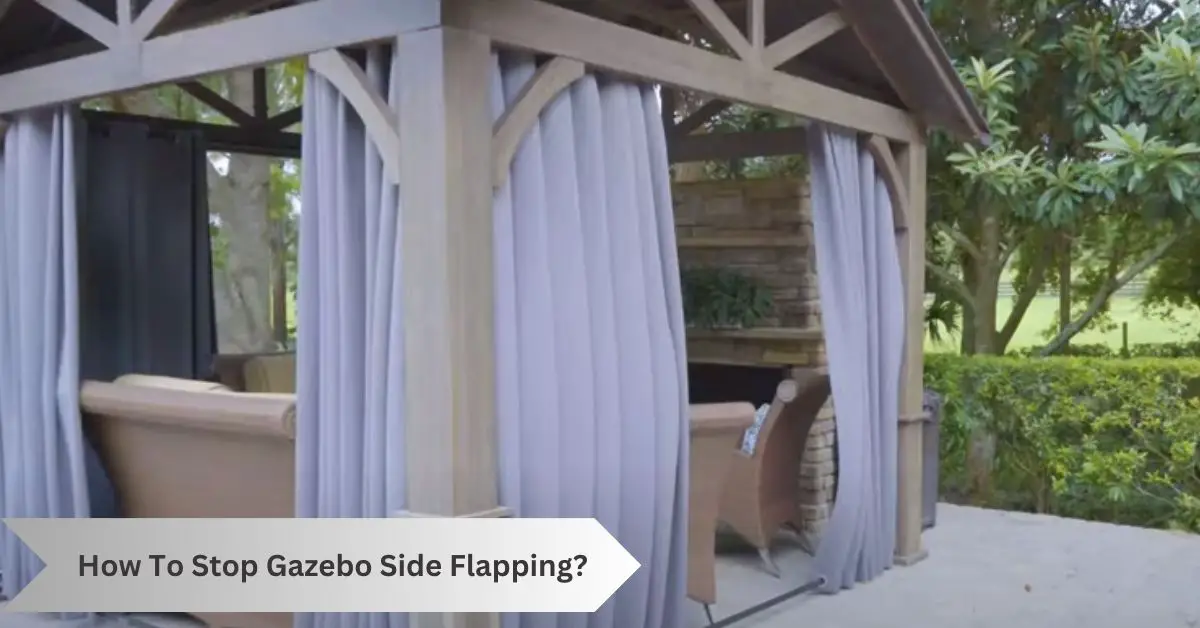Gazebo side flapping can be a frustrating problem for anyone who owns a gazebo. It can make it difficult to enjoy outdoor activities, as the flapping noise and movement can be distracting and even dangerous in certain situations.
However, there are several steps you can take to prevent gazebo side flapping and ensure a more enjoyable outdoor experience.
Whether you are a seasoned gazebo owner or are new to the world of outdoor living, this guide will provide you with the information you need to solve the problem of gazebo side flapping once and for all.
How To Stop Gazebo Side Flapping: To stop Gazebo side flapping, secure the sidewalls tightly using clips or weights. Adjust tension on ropes or bungee cords to minimize wind resistance. Additionally, position the gazebo in a sheltered location to reduce the impact of gusts.
How To Stop Gazebo Side Flapping? Different Ways
Gazebos are great for outdoor events, camping, and street food markets. However, because they are temporary structures, they can get damaged easily in bad weather, incredibly windy.
It’s really important to keep your gazebo from blowing away in the wind because it can cause damage to people and things around it.
There are several ways to keep your gazebo secure in the wind, like using weights on the legs, tying it down with ropes and pegs, and using anchoring kits, straps, or rods. The method you choose will depend on the surface where you set up your gazebo.
Types of Ground Surfaces
The kind of surface where you plan to put your gazebo will usually determine how you should keep it from blowing away in the wind.
To set up a Gazebo on Concrete:
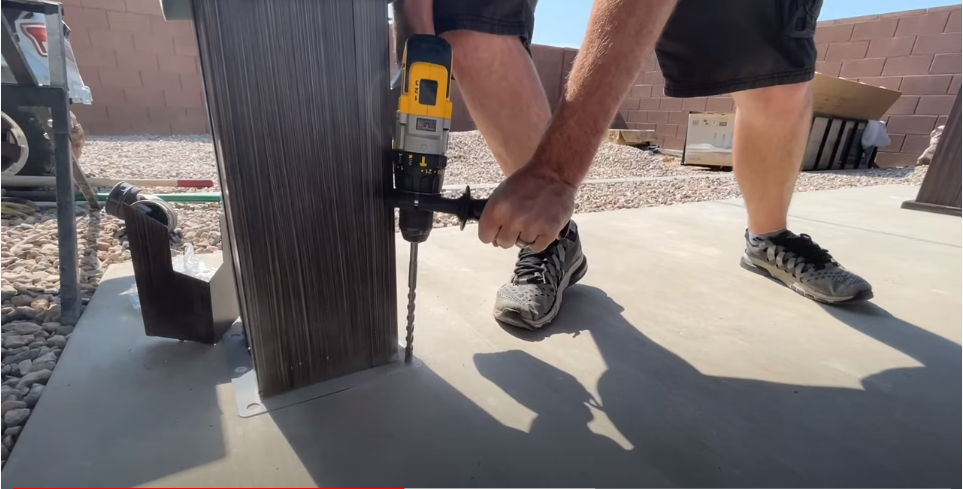
Concrete is a great surface to set up your gazebo because it’s flat and even. To keep your gazebo from moving on concrete, you can use leg weights or straps made of a strong material called polypropylene.
Securing a Gazebo on Grass:
Grass surfaces may not be as flat and even as concrete, but they do offer more options for keeping your gazebo secure in windy weather. Besides using leg weights and polypropylene straps, like on concrete surfaces, you can also use pegs, rope, threaded rods, and anchoring kits on the grass.
Using Threaded Rods to Secure Your Gazebo
If you want to use your gazebo as a permanent structure and don’t plan to take it down very often, then threaded rods are a good way to keep it secure in strong winds. To do this, you’ll need to use two rods per leg (depending on the gazebo leg design, you may need to drill into the feet).
It’s important to use long enough rods, with experts recommending rods that are at least 24 inches long.
Securing Gazebo with Weights
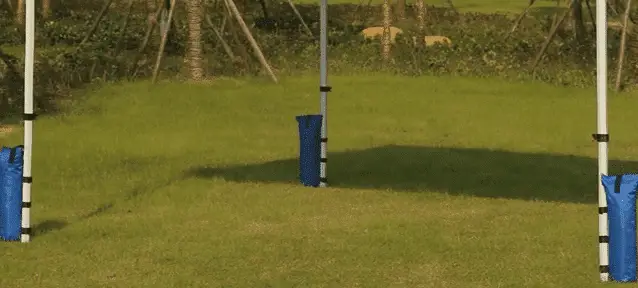
Gazebo leg weights are a great way to keep your gazebo secure in strong winds, and you can use them on any surface like concrete or grass. There are different types of leg weights, such as cast-iron weights that slide over the feet of the gazebo legs or sand and water-filled bags that clip onto the legs.
Experts recommend having between 15-25kg of weight per leg (60-100 kg in total) to make sure your gazebo is safely secured.
Anchoring to Nearby Gazebos or Structures
Here’s a final tip that I like to use when I’m selling food at markets and it’s windy outside: use leg weights to secure my gazebo, and also anchor it to other gazebos or fixed structures. I do this by using a bungee cord to tie the legs of two gazebos together. This is helpful when there are gazebos on either side of me.
Using Pegs and Ropes to Secure Your Gazebo
Ropes and pegs are another common way to keep your gazebo from blowing away on grassy surfaces. To do this, push gazebo stakes into the ground in each of the four corners of the gazebo a couple of meters away.
Then, use a strong rope or thick cord to thread through the stakes and up to the crossbars of each corner of the gazebo’s inner roof. If it’s windy, you can add extra pegs and ropes, so you have eight total for all corners and sides of the gazebo. This will give you extra safety in incredibly windy conditions.
Using Polypropylene Straps to Secure Your Gazebo
Polypropylene Straps, also known as “ratchet tie-down straps,” are a good solution for securing your gazebo in high winds. These straps are very strong and have a high breaking point (the product in the image has a 1500 lb breaking point), which means it takes severe weather before your gazebo gets blown away.
With the ratchet function, you can ensure the straps are very tight, minimizing any slack that might cause the gazebo to shake. However, to use ratchet straps effectively, you’ll need a heavy fixed structure or steel rings embedded into a concrete surface for the metal hooks to attach.
Using Fishing Weights to Secure Your Gazebo
You can buy fishing weights and sew them into the bottom hem to keep your outdoor curtains from flapping around. Make sure to sew a pocket for each weight as you go so they don’t all bunch up on one side when you slide the curtains.
If sewing is not your thing, you can also hang the fishing weights from the bottom of the curtains. This same method can be used to weigh down your outdoor tablecloth too.
Make Your Weights using River Stones.
Use your crafting skills to create unique outdoor curtain weights to enhance the appearance of your outdoor space. Collect attractive river stones from a local riverbank or buy them from Amazon. Tie a craft wire around each stone and create loops. Then, attach clips to the loops, and your DIY project is complete!
Using Utility Chains for Maximum Benefit
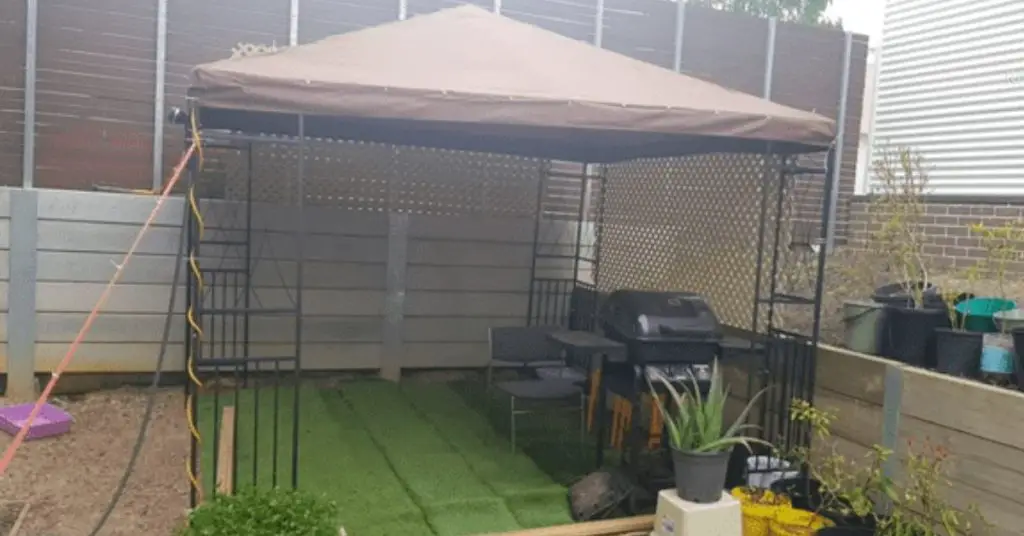
To make your outdoor curtains heavy, you can use a stainless steel chain that you can buy at a hardware store or online. First, you need to remove the stitching on the sides of the bottom hem of the curtain and then run the chain through the opening.
After that, stitch the sides back up, and you’re done! This will make the curtains heavier and less likely to blow around in the wind. However, if the wind gets too strong, it’s recommended to pin the curtains back to avoid any potential dangers.
Consider Using Washers for Your Project
You can use big washers from your garage to weigh down your outdoor curtains or secure your outdoor carpet without spending any money. Use washers that are M12 to M20 in size as they are heavier and can withstand strong winds. You can sew them in the bottom seam of your curtain or let them hang from the edge as an embellishment.
Embrace Curves in Your Design
To reduce the effect of wind on your outdoor curtains, it’s best to keep them scalloped at the top. This means not pulling the top of the curtains straight across the rod, as this can cause them to flap around.
Instead, letting the curtains drape creates a more relaxed effect, which allows the wind to pass over the curtains instead of pulling them. If you use tab-top curtains with deep cuts, they’re ideal for outdoor use.
Hold Your Curtains in Place with Clips
To reduce the impact of wind, you can use clips to connect the individual drapes to create a bigger and heavier surface. This method may not completely solve the problem, but it will help to make it better.
You can use stainless steel clips or binder clips, which can be kept in a small basket on your outdoor table, so you can quickly get them when the wind starts to blow.
Create Wind Openings for Better Airflow
If you make cuts in your outdoor curtain, wind can pass through them instead of causing the curtain to fly around. You can do this by making one or two rows of vertical cuts on the fabric, then folding and sewing the edges to prevent fraying. It’s best to make the cuts on the back fold of the pleat, so they won’t be visible when the curtains are open.
Secure Your Curtains with Ties
If your outdoor curtains blow away quickly, you can tie them to the ground using tarp grabbers and cup hooks. Attach the bottom corners of each drape to the ground with these tools. If the curtains are too low, use bungee balls to extend the length of the cup hooks.
However, remember that the curtains will bulge to the side, creating a sailboat effect.
11 Simple Steps to Hang Curtains on Your Gazebo
If you want to make curtains for your gazebo, you have to buy the right fabric, measure it, install curtain rods, and add attachment points for each curtain. It’s a lot of work.
Alternatively, you can buy a full curtain set like curtains for the Dakota Gazebo. It comes with everything you need and can be installed within an hour. You only need to follow some simple steps to hang the curtains.
How to Install Curtains:
To hang the curtains, start by attaching the left side of the first panel to the hook in the corner of the pavilion. Then, connect the next panel to the same hook and continue moving to the right until you reach the corner of the gazebo.
Repeat this for all four panels so that each one goes around a corner and meets in the middle of the wall to be zipped together.
Gather Your Materials and Tools:
Get everything you need to put up your curtains, such as a friend to help you, the curtains and hooks that come with them, and the gazebo.
Securing Your Curtains in an Open or Closed Position:
After setting up the curtains, you have two options. You can zip the curtains together to enclose the gazebo or use the included straps to keep the curtains open and attach them to each corner post.
How to Install Hooks on a Curtain Track:

If you haven’t installed the hooks yet, attach them to the outer curtain track on your gazebo. This track is the one closest to the frame, not the one closest to the inside of the gazebo, which is for mosquito netting.
If mosquito netting is on your gazebo, removing it and putting it back up once the curtains are installed might be easier.
Adding Style to Your Curtains with Tie-Backs:
Decorative curtain tie-backs are a great way to add a stylish touch and keep your curtains open. These tie-backs can be made from various materials such as ribbon, rope, or tassels and come in various colors and designs to match your decor.
First, use decorative tie-backs to pull your curtains to the desired open position. Then, wrap the tie-back around the curtain, ensuring it’s tight enough to hold it in place. You can tie the tie-back in a knot, bow, or any other decorative style that you prefer.
Not only do decorative tie-backs add a finishing touch to your curtains, but they also help to keep them open, allowing natural light to enter the room. Additionally, tie-backs can help to prevent the curtains from blowing around in the wind, making them ideal for outdoor use.
How to Magnetise Your Curtains:
Sew the magnets into the curtains: Sew one magnet into the top corner of each curtain panel. Make sure the magnet is on the inside of the fabric and that the polarity is consistent across all the magnets.
Attach the curtains to the metal frame: If your gazebo or outdoor space has a metal frame, the magnets will stick to it and hold it in place. If there is no metal frame, you can attach a metal strip to the top of the frame to create a surface for the magnets to attach.
Enjoy your magnetized curtains: With the magnets in place, your curtains will stay put even on the windiest of days, allowing you to enjoy your outdoor space without annoying distractions.
Holding Your Curtains in Place with Heavy Furniture:
One way to keep your curtains from blowing around is to wedge them between heavy pieces of furniture. Pushing your couch or chairs against the walls on either side of your window and tucking the curtains behind the furniture can help keep them in place.
You can also use bookshelves or other heavy items to keep the curtains from flying around in the wind. This method is ideal for those who want a quick, easy solution without additional materials or tools.
Using Potted Plants to Secure Your Curtains:
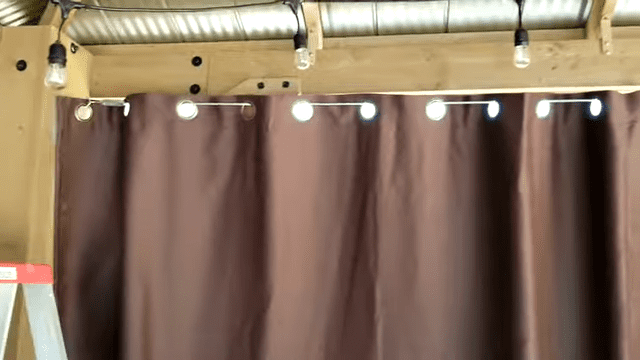
You’ll need to place the potted plants near the corners of your windows or doors to wind the curtains around heavy pot plants. Open the curtains and wrap them around the pot plants, ensuring the fabric is not too tight or loose.
Use plant ties or string to secure the curtains around the pot plants. This method keeps the curtains from blowing in the wind and adds a decorative touch to your home or outdoor space. Just choose heavy and sturdy pot plants that won’t tip over easily.
Adding a Decorative and Heavy Cord to the Hem of Your Curtains:
To add weight to your curtains, you can sew a heavy and decorative cord along the bottom hem of the fabric. This will help to keep the curtains in place and prevent them from blowing around in the wind.
You can choose a cord that matches the colour and style of your curtains to make it a decorative feature or opt for a neutral color that will blend in with the rest of the room. Use a strong thread and sew the cord securely to ensure it won’t lose over time.
Adding a Heavy-Duty Cable to the Hem of Your Curtains:
To secure your outdoor curtains against strong winds, you can run a heavy-duty cable through the hem. Here’s how to do it:
- Measure the length of your curtain and add a few extra inches to the measurement.
- Sew a hem on the bottom of the curtain, leaving an opening at each end.
- Thread the cable through the hem, ensuring it runs the entire curtain length.
- Secure the cable at each curtain’s end by looping it around a sturdy object or tying it to a hook.
- Use a turnbuckle to tighten the cable and keep the curtains taut.
The heavy-duty cable will add weight to the curtains and prevent them from blowing around in the wind.
Securing the Hem of Your Curtains to the Ground:
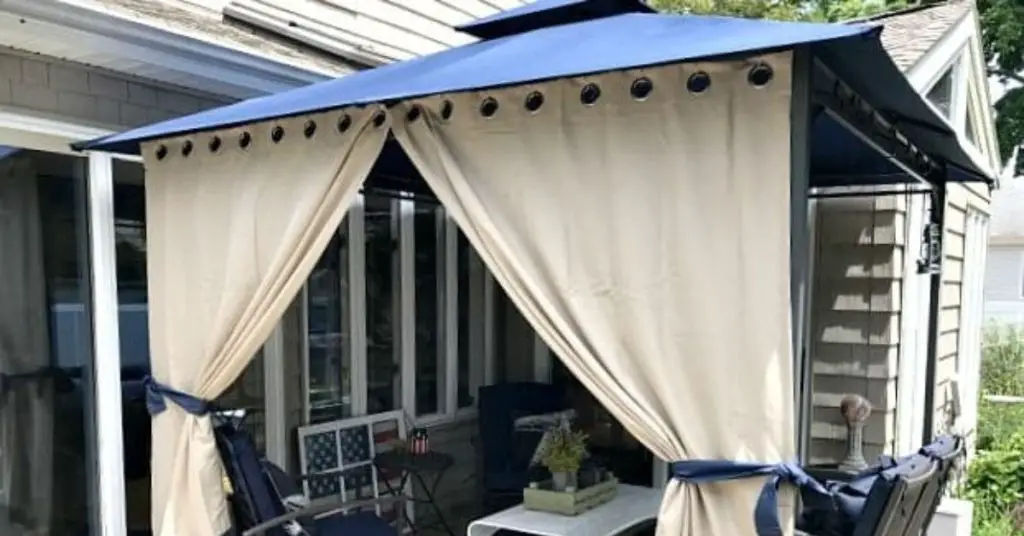
You can use landscape fabric staples or tent stakes to anchor the hem of your outdoor curtains into the ground. First, fold the bottom hem of your curtain up about 6 inches. Then, use the staples or stakes to secure the folded hem to the ground.
Space the staples or stakes about 6-12 inches apart along the length of the curtain. This will help prevent the curtain from flapping in the wind and keep it securely in place.
The Advantages of Using Curtains for Your Gazebo
If we haven’t convinced you to get curtains for your gazebo yet, here are all the benefits that they can provide.
Keeping Mosquitoes at Bay with Gazebo Curtains:
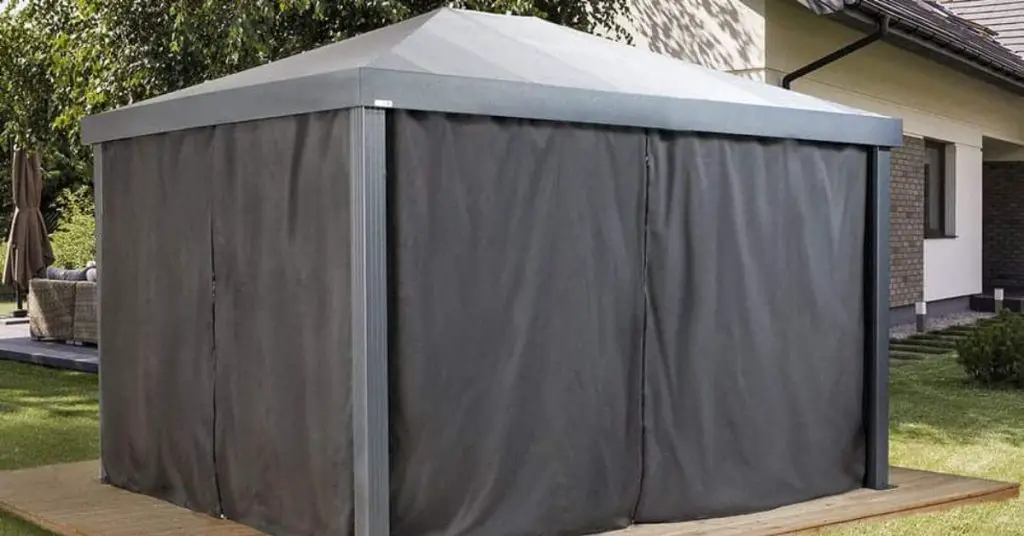
Mosquitoes can ruin summer evenings, as they can cause itching and discomfort. Adding curtains or mosquito nets to your gazebo can reduce the number of mosquitoes and other flying insects. This can make your summer evenings more enjoyable and less stressful.
Protecting Your Gazebo from the Elements with Curtains:
Curtains can help protect you from different types of weather. They can protect you from rain, wind, and harmful UV rays. During the hot summer months, they can keep you cool and shaded, while during the colder months, they can keep you warm and cosy when used with a portable patio heater.
Most gazebo curtains are also made with water-resistant material to keep you dry during rainy weather.
Adding Style and Elegance:
Did you know that curtains can also enhance the look of your gazebo? They can add a touch of elegance and style, making your gazebo look more inviting and cosy.
You can experiment with different colors and textures to create the perfect ambience for your space. Plus, curtains can be tied back to let in more light or left closed for more privacy. It’s all up to you and your style!
Creating a Private Space:
Curtains can turn your gazebo into a private space where you can relax without being seen by others. In busy cities or suburbs, finding outdoor spots where you can have privacy can be tough. Your backyard should be where you feel comfortable and safe; even a simple curtain can help with that.
Exploring Different Styles of Gazebo Curtains
You can add different types and styles of curtains to your gazebo, but the two main types are solid fabric curtains and mosquito netting. Solid fabric curtains provide full coverage for privacy and weather resistance to block rain, wind, and sight.
Mosquito netting mainly keeps bugs out but also provides some weather coverage and a less obstructed view than solid fabric curtains.
Using Mosquito Netting for Your Gazebo:
Mosquito netting is a different type of gazebo covering. Mosquito nettings are made of polyester netting with a PVC coating and can be hooked onto the pavilion.
These curtains are light and help keep flying insects away while allowing fresh air in and providing an outside view.
Choosing the Right Fabric:
Outdoor curtains are made of a unique polyester fabric that can handle different weather conditions. This fabric is water-resistant, so it doesn’t get wet quickly when it rains. It also has built-in protection against UV light, which helps to protect the fabric from fading.
You can use these curtains outdoors without worrying about them getting damaged quickly. The fabric is also easy to handle, so you can install and remove the curtains when cleaning them.
Different Sizes of Gazebo Curtains to Fit Your Needs:
There are curtains and netting available for various types and sizes of gazebos. Some curtains are made to fit a particular brand of gazebo, making installation more convenient and ensuring a proper fit.
It’s best to get curtains that match the type of gazebo you have, such as rectangular curtains for a Sedona 10 x 12 ft gazebo or circular curtains for a Komodo Hardtop 12 x 15 ft gazebo.
Changing the Materials used for the Roof
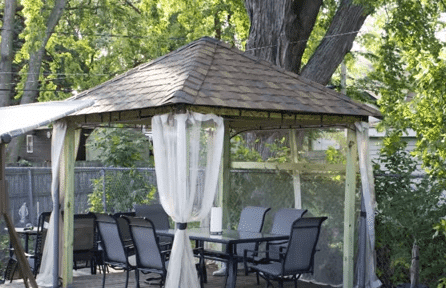
Changing the materials used for the roof can significantly impact the look, durability, and performance of a gazebo.
Some popular materials for gazebo roofs include metal, shingles, thatch, and polycarbonate panels. Each material has advantages and disadvantages, such as durability, weather resistance, and cost.
Metal roofs are durable and long-lasting but can be noisy during heavy rain or hail. Shingles are a traditional choice and come in various colors and styles, but they require more maintenance and are not as durable as metal.
Thatch roofs provide a natural and unique look but may require more frequent replacement and are not as weather-resistant as other materials. Polycarbonate panels are lightweight and provide good UV protection but can be more expensive.
When considering a roofing material for your gazebo, choosing one that fits your area’s budget, style, and weather conditions is essential.
Preventing Gazebo Side Flapping in the Future
To prevent the gazebo side from flapping in the future, it’s essential to follow best practices during the initial setup of the gazebo model. This includes making sure all of the pieces are securely attached and tightened.
It’s also a good idea to periodically check the gazebo to ensure that all pieces are still securely in place and that the model is configured correctly.
Some additional tips to prevent side flapping include ensuring that the gazebo is set up in an area sheltered from high winds, using guy ropes to anchor the gazebo to the ground, and adding weight to the base of the gazebo using sandbags or water weights.
Choosing a gazebo made with sturdy materials and designed to withstand the weather conditions in your area is also essential.
Preventative Measures
Preventative measures can help avoid gazebo side flapping in the future. Regular gazebo maintenance ensures all parts are secure and functioning correctly.
Before using the gazebo, it’s also essential to check the weather conditions to avoid setting up in windy conditions. Reinforcing the gazebo structure with additional support, such as weights or sandbags, can also prevent the gazebo from being lifted by strong winds.
It’s crucial to periodically check the gazebo’s setup to ensure it is appropriately configured and take appropriate action if any issues are identified.
By following these best practices, you can minimize the risk of gazebo side flapping and ensure your gazebo’s safe and enjoyable use.
FAQs:
Q:1 How do you stop Gazebo sides from Flapping?
The simplest way to secure a pop-up gazebo is to tie heavy weights to the base. This and tent pegs are the most effective and easy way to keep your gazebo from moving around.
Q:2 How do you Weigh down a Gazebo side?
Sandbag leg weights are an affordable option to secure your gazebo on the hard ground during normal weather conditions. These weights come in four sets; you can fill them with sand or fine pea shingle. Once filled, you can strap them to the base of the gazebo legs to add extra anchorage.
Q:3 Is leaving the sides on a Gazebo in the Wind better?
Make sure your marquee is securely anchored by using tie-down kits at a minimum. Keep the walls up on the side of the marquee facing strong winds, and position the entrance on a different side. Never remove all the sides of a marquee during strong winds.
Q:4 How do you make a Gazebo Stable?
It’s important to secure gazebos to the ground to avoid accidents properly. There are three ways to anchor a gazebo to pavers: drilling it directly into the pavers, driving concrete footers between pavers, or using weights.
Q:5 What is the Best Way to Anchor a Gazebo?
The most popular way to secure a gazebo is to use straps around the base of the gazebo legs. You can tie the straps or use a ratchet to secure them. When tying, make sure to use a double knot to ensure that the straps are secure. Alternatively, you can attach the straps to nearby trees or posts to anchor your gazebo.
Conclusion:
In conclusion, preventing gazebo side flapping can be achieved by properly securing the gazebo to the ground, checking the weather conditions before use, and reinforcing the gazebo structure.
Various methods to anchor a gazebo include weights, tie-down kits, or sandbags. The appropriate anchoring method is essential based on the ground surface and weather conditions.
Periodic checks and regular gazebo maintenance are also essential to ensure it remains appropriately configured and secure.
Following these best practices lets you enjoy your gazebo without worrying about it flapping in the wind.
After reading this comprehensive guide, we hope you will be well aware of how to stop Gazebo side Flapping. If you have any questions, feel free to comment below!

